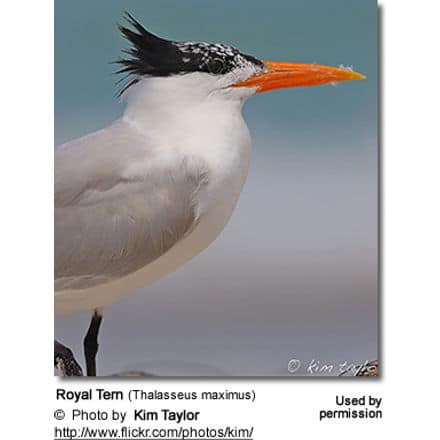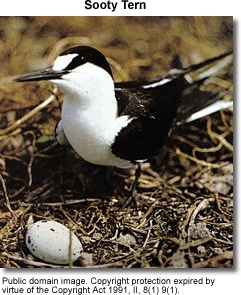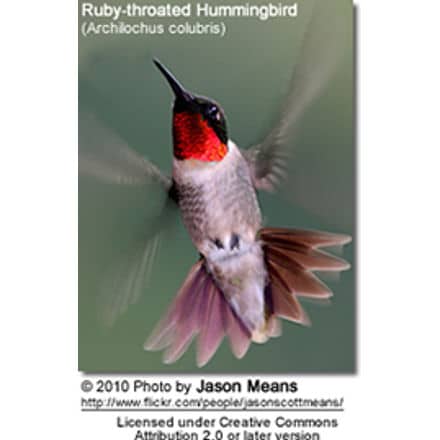Terns
Terns are seabirds with a worldwide distribution, that are related to the waders, auks and skimmers. Terns are generally long-lived. Several species live for 25-30 years and longer.


Terns are seabirds with a worldwide distribution, that are related to the waders, auks and skimmers.
Terns are generally long-lived. Several species living to 25-30 years and longer.
Distribution / Range
Many terns breeding in temperate zones are long-distance migrants, traveling north or south to their wintering territories after the breeding is completed.
Some remain in their breeding territories.
Terns are protected species to which the Agreement on the Conservation of African-Eurasian Migratory Waterbirds (AEWA) applies.
Description
Terns are medium to large seabirds – the smallest tern being the Least Tern, weighing 1.5 oz (42 g) and measuring 9 inches (23 cm), to the largest — the Caspian Tern, weighing 1.4 lbs (630 g) and measuring 21 inches (53 cm). They are lighter bodied and more streamlined than gulls.
The plumage is mostly grey or white, typically with black markings on the head. They have longish bills and webbed feet.
The Terns in the genus Sterna have deeply forked tails. Genus Chlidonias and Larosterna have shallowly forked tails. Noddies (genera Anous, Procelsterna, Gygis) have ‘notched wedge’ shaped tails, with the longest feathers in the tail being the middle-outer, not the central nor the outermost.
Terns only rarely swim, despite having webbed feet.
Terns usually differ from gulls in their smaller size, narrower wings and a more slender build; a sharply pointed bill and an often forked tail
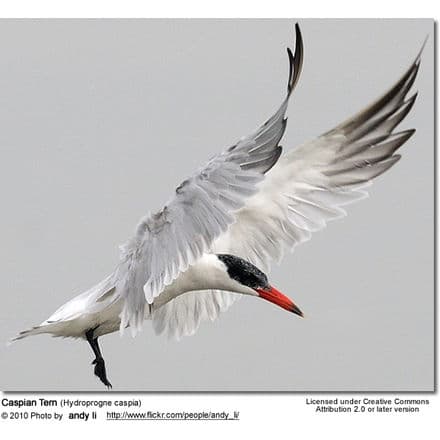

Feeding / Diet
Terns usually forage alone or in groups around estuaries, lagoons and mangroves.
They mostly feed mostly on small fish – and to a lesser extent on squid, shrimp and crabs.
Most terns (Sterna and the noddie) fly several meters above the surface of water and dive to catch fish, sometimes hovering above the water before plunge diving.
Marsh terns (Chlidonias) usually skim insects of the surface of fresh water.
They may also perform aerial skimming; or steal food from other terns.
As is customary in bird species, the male will offer fish to the female as part of the courtship display.
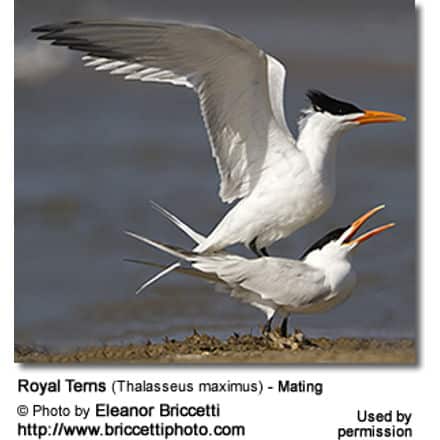
Breeding / Nesting
Terns often breed in large and dense mixed breeding colonies (100 to 4,000 breeding pairs) on coasts and islands.
As part of the courtship displays, the male brings back a fish for the female. She may swallow the fish immediately, but on occasion she keeps it in the bill during the display.
During the display, both the male and female take off and fly high into the air in tandem, with alternated glides. The male will continue to feed her throughout the breeding season.
Terns are mostly ground breeders and scrape out a nest in the soil. As their breeding grounds are often flooded, they defecate directly on the rim of their nests. The hardened feces may prevent the nest from being washing away. Some may also find odd nesting sites, such as rooftops.
The average clutch consists of one to two eggs, which are incubated by both the male and female for about 25 – 31 days. Even though Terns are fiercely defensive of their nest sites and chicks, the eggs are often destroyed by sand crabs; the eggs and chicks are preyed upon by the Black-headed Gull; while Laughing Gulls and Ruddy Turnstones only take the eggs.
The hatchlings are greyish or buffy in color, sometimes with darker spots. Within one day of hatching, the chicks usually leave the nest to join a communal creche, where hundreds and even thousands of chicks congregate. The parents are able to find their chicks in the crowd (probably recognizing their calls) and feed them.
The surviving young learn to fly when they are about one month old. They continue to receive parental care for about 5 – 8 months and migrate to the winter territories with them.
They are of breeding age when they are about 3 – 4 years old.
Calls / Vocalizations
Their calls are described as harsh, single-note calls.
Sub-species:
Black-fronted Tern
California Least Tern (Sternula antillarum brownii)
Forster’s Tern
Inca Tern (Larosterna inca): whozoo.org
Peruvian Tern (Sternula lorata)
Roseate Tern Tern aka Graceful Tern (Sterna dougallii)
Saunders’s Tern (Sternula saundersi)
White-fronted Tern (Sterna striata) – also known as Black-naped Tern
Yellow-billed Tern (Sternula superciliaris)

